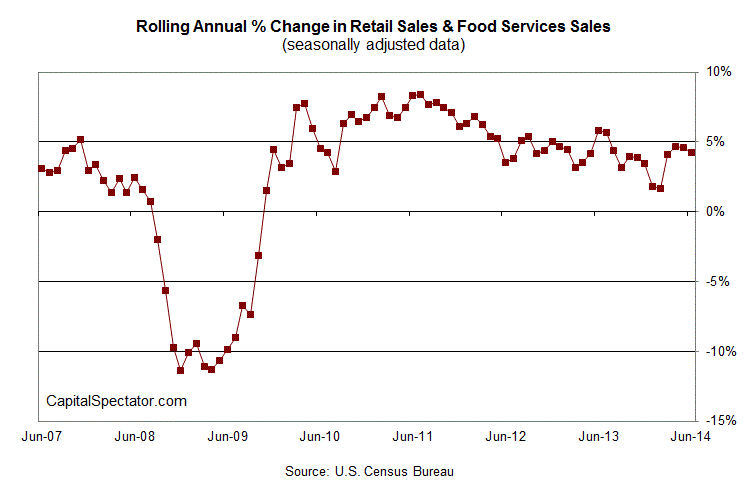Retail sales increased less than expected in June, rising a sluggish 0.2% vs. the 0.6% advance that the market was looking for. But there are a couple of reasons for thinking that this is mostly short-term noise as opposed to a warning sign for the business cycle. First, the previous month’s increase was revised up to 0.5% from the initially reported 0.3%. More importantly, the year-over-year pace for retail spending is still climbing at a decent rate: 4.3% through June. That’s down from 4.6% in the previous month, but it’s par for the course lately in keeping with a moderately faster annual gain in recent months relative to the winter.
Stripping out gasoline sales shows that retail spending is even stronger. For the year through last month, consumers increased consumption by 4.8% ex-gasoline.
No one will confuse the latest numbers as a blow-out report. But moderately higher spending patterns appear poised to continue for the foreseeable future, in part because the rest of the economy is still forging ahead. Ultimately, retail spending is linked with wage growth. Private-sector wages are increasing around 2% a year in recent history and so it’s not surprising that retail spending on a year-over-year basis is having a tough time running any higher than what we’ve seen lately. But wage growth and retail spending have been relatively stable in recent months, and so the case for moderate growth remains a reasonable outlook. Looking further out in time, there may be a price to pay if wage growth doesn’t pick up. But that’s a subject for another day.
Meanwhile, the potential for stronger data in the months ahead still looks plausible. Growth has picked up a bit in private-sector payrolls in recent months. Although the numbers are far from conclusive, we may see the modestly faster increase in jobs of late turn into better spending numbers. Yes, that’s still a speculative notion at the moment. What is clear is that the economy continues to expand at a moderate rate. It’s debatable if we’re going to see an acceleration, but the downside risk for growth in broad macro terms still looks like a low-probability threat.
